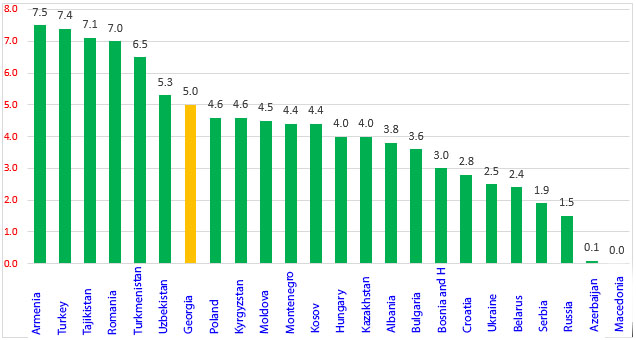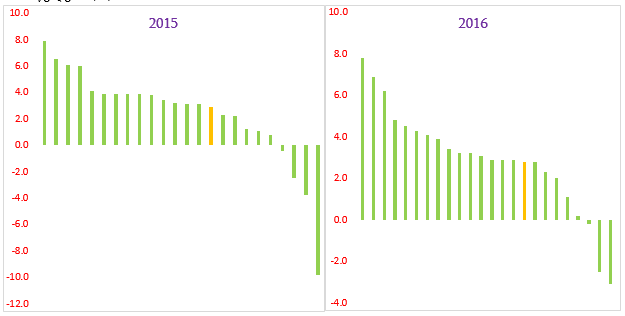Verdict: FactCheck concludes that Irakli Kobakhidze’s statement is HALF TRUE.
Resume: In 2017, Georgia’s economic growth constituted 5% which put Georgia in the 7th position of the region’s 24 countries. The average regional economic growth is 4.1%. Even though Georgia occupies the 7th position in terms of economic growth rates, it is hard to plainly consider this position as “one of the highest.” On the one hand, the economic growth rate of the immediate neighbour countries (Armenia, Turkey) is much higher. On the other hand, the performance of the next five countries in the ranking after Georgia is within the margins of 4.4% - 4.6% which is not considerably below Georgia’s result.
In accordance with the Ministry of Finance of Georgia and the World Bank, Georgia’s economic growth rate for 2018 is estimated to be 4.5% whilst the International Monetary Fund (IMF) prognosticates a 5.5% economic growth rate for the country. Of note is that the IMF increased its estimates after Georgia showed a 5.5% economic growth in the first seven months of this year. Despite a relatively high economic growth rate in the first half of 2018, Georgia’s economic growth constituted 4.6% in July and much lower – 2.0% – in August. In addition, the real economic growth is estimated to be 5% according to the 2019 draft state budget (which the Government of Georgia submitted to the Parliament of Georgia last week). Furthermore, according to World Bank Georgia, the country’s economic growth rate is estimated to reach 4.5% which puts it in the 6th position in the region.
Analysis
Speaker of the Parliament of Georgia, Irakli Kobakhidze, spoke about economic growth. He stated that Georgia stands out in the region owing to its 5% economic growth rate in 2017, which was one of the highest performances in the entire region, and a 5% estimated economic growth rate for 2018.
It is important to clearly define the region in which Georgia belongs because this does have relevance in terms of making any comparisons. In accordance with the World Bank’s methodology, Georgia belongs to the group of European and Central Asian countries (excluding the high-income countries). The characteristics of the economies of these countries are more or less similar. Therefore, Georgia’s economic growth rate should be analysed against the group of the 24 non-high-income European and Central Asian countries.
Georgia’s economic growth rate was 5% last year whilst the average economic growth rate for the European and Central Asian region was 4.1%. Georgia was ranked 7th of the 24 countries of this group. In turn, the country’s high economic growth rate in 2017 is fully related to the improvement in the regional economic situation as compared to previous years and is mostly the result of the high economic growth in Georgia’s top trade partners which contributed to the increased foreign demand and the significant growth of Georgia’s economy. In the same year, Armenia (7.5%), Turkey (7.4%), Tajikistan (7.0%), Turkmenistan (6.5%), Uzbekistan (5.3%) and Poland (4.6%) had the highest regional economic growth rates.
Graph 1: Economic Growth Rates of European and Central Asian Region Countries, 2017 (%)
 Source: Global Economic Prospects: JUNE 2018, World Bank
In 2015, Georgia was ranked 15th in the region with a 2.9% economic growth rate whilst the average regional economic growth rate constituted 2.4% in the same year. In 2016, Georgia’s economic growth was 2.8% which put the country in the 16th position in the ranking whilst the regional average economic growth rate was 2.9%. Uzbekistan, Tajikistan and Turkmenistan showed a strong economic performance within the regional grouping in the same year.
Graph 2: Economic Growth Rate of European and Central Asian Region Countries, 2015-2016 (%)
Source: Global Economic Prospects: JUNE 2018, World Bank
In 2015, Georgia was ranked 15th in the region with a 2.9% economic growth rate whilst the average regional economic growth rate constituted 2.4% in the same year. In 2016, Georgia’s economic growth was 2.8% which put the country in the 16th position in the ranking whilst the regional average economic growth rate was 2.9%. Uzbekistan, Tajikistan and Turkmenistan showed a strong economic performance within the regional grouping in the same year.
Graph 2: Economic Growth Rate of European and Central Asian Region Countries, 2015-2016 (%)
 Source: Global Economic Prospects: JUNE 2018, World Bank
In regard to the economic growth rate estimated for this year, Georgia’s 2018 state budget is based on a 4.5% economic growth rate which matches with the prognosis published by the World Bank in June. As concerns the International Monetary Fund (IMF), its initial prognosis was 4.5% and was increased to 5.5% in August. The growth in the IMF’s estimates was stipulated by the high actual growth rate (as compared to the estimates) registered in the first half of 2018. However, in accordance with data published by the National Statistics Office of Georgia, economic growth in August was 2.0% whilst the average economic growth rate for January-August 2018 was 4.8%. Therefore, achieving a 5.5% economic growth rate in 2018 seems less likely.
In accordance with the World Bank, a 2.3% economic growth rate is estimated for the European and Central Asian region whilst Georgia’s economic growth is prognosticated to reach 4.5%. Based on economic growth estimates, Georgia is ranked 6th in the ranking of the region’s 24 countries. In accordance with the World Bank’s prognosis, Georgia will rank 5th in 2019 with a 4.8% economic growth rate and maintain this 5th position in 2020 with a 5.0% economic growth rate.
Graph 3: Economic Growth Rate of European and Central Asian Region Countries, 2018 (Estimates %)
Source: Global Economic Prospects: JUNE 2018, World Bank
In regard to the economic growth rate estimated for this year, Georgia’s 2018 state budget is based on a 4.5% economic growth rate which matches with the prognosis published by the World Bank in June. As concerns the International Monetary Fund (IMF), its initial prognosis was 4.5% and was increased to 5.5% in August. The growth in the IMF’s estimates was stipulated by the high actual growth rate (as compared to the estimates) registered in the first half of 2018. However, in accordance with data published by the National Statistics Office of Georgia, economic growth in August was 2.0% whilst the average economic growth rate for January-August 2018 was 4.8%. Therefore, achieving a 5.5% economic growth rate in 2018 seems less likely.
In accordance with the World Bank, a 2.3% economic growth rate is estimated for the European and Central Asian region whilst Georgia’s economic growth is prognosticated to reach 4.5%. Based on economic growth estimates, Georgia is ranked 6th in the ranking of the region’s 24 countries. In accordance with the World Bank’s prognosis, Georgia will rank 5th in 2019 with a 4.8% economic growth rate and maintain this 5th position in 2020 with a 5.0% economic growth rate.
Graph 3: Economic Growth Rate of European and Central Asian Region Countries, 2018 (Estimates %)
 Source: Global Economic Prospects: JUNE 2018, World Bank
Source: Global Economic Prospects: JUNE 2018, World Bank
 Source: Global Economic Prospects: JUNE 2018, World Bank
In 2015, Georgia was ranked 15th in the region with a 2.9% economic growth rate whilst the average regional economic growth rate constituted 2.4% in the same year. In 2016, Georgia’s economic growth was 2.8% which put the country in the 16th position in the ranking whilst the regional average economic growth rate was 2.9%. Uzbekistan, Tajikistan and Turkmenistan showed a strong economic performance within the regional grouping in the same year.
Graph 2: Economic Growth Rate of European and Central Asian Region Countries, 2015-2016 (%)
Source: Global Economic Prospects: JUNE 2018, World Bank
In 2015, Georgia was ranked 15th in the region with a 2.9% economic growth rate whilst the average regional economic growth rate constituted 2.4% in the same year. In 2016, Georgia’s economic growth was 2.8% which put the country in the 16th position in the ranking whilst the regional average economic growth rate was 2.9%. Uzbekistan, Tajikistan and Turkmenistan showed a strong economic performance within the regional grouping in the same year.
Graph 2: Economic Growth Rate of European and Central Asian Region Countries, 2015-2016 (%)
 Source: Global Economic Prospects: JUNE 2018, World Bank
In regard to the economic growth rate estimated for this year, Georgia’s 2018 state budget is based on a 4.5% economic growth rate which matches with the prognosis published by the World Bank in June. As concerns the International Monetary Fund (IMF), its initial prognosis was 4.5% and was increased to 5.5% in August. The growth in the IMF’s estimates was stipulated by the high actual growth rate (as compared to the estimates) registered in the first half of 2018. However, in accordance with data published by the National Statistics Office of Georgia, economic growth in August was 2.0% whilst the average economic growth rate for January-August 2018 was 4.8%. Therefore, achieving a 5.5% economic growth rate in 2018 seems less likely.
In accordance with the World Bank, a 2.3% economic growth rate is estimated for the European and Central Asian region whilst Georgia’s economic growth is prognosticated to reach 4.5%. Based on economic growth estimates, Georgia is ranked 6th in the ranking of the region’s 24 countries. In accordance with the World Bank’s prognosis, Georgia will rank 5th in 2019 with a 4.8% economic growth rate and maintain this 5th position in 2020 with a 5.0% economic growth rate.
Graph 3: Economic Growth Rate of European and Central Asian Region Countries, 2018 (Estimates %)
Source: Global Economic Prospects: JUNE 2018, World Bank
In regard to the economic growth rate estimated for this year, Georgia’s 2018 state budget is based on a 4.5% economic growth rate which matches with the prognosis published by the World Bank in June. As concerns the International Monetary Fund (IMF), its initial prognosis was 4.5% and was increased to 5.5% in August. The growth in the IMF’s estimates was stipulated by the high actual growth rate (as compared to the estimates) registered in the first half of 2018. However, in accordance with data published by the National Statistics Office of Georgia, economic growth in August was 2.0% whilst the average economic growth rate for January-August 2018 was 4.8%. Therefore, achieving a 5.5% economic growth rate in 2018 seems less likely.
In accordance with the World Bank, a 2.3% economic growth rate is estimated for the European and Central Asian region whilst Georgia’s economic growth is prognosticated to reach 4.5%. Based on economic growth estimates, Georgia is ranked 6th in the ranking of the region’s 24 countries. In accordance with the World Bank’s prognosis, Georgia will rank 5th in 2019 with a 4.8% economic growth rate and maintain this 5th position in 2020 with a 5.0% economic growth rate.
Graph 3: Economic Growth Rate of European and Central Asian Region Countries, 2018 (Estimates %)
 Source: Global Economic Prospects: JUNE 2018, World Bank
Source: Global Economic Prospects: JUNE 2018, World Bank
Tags:








